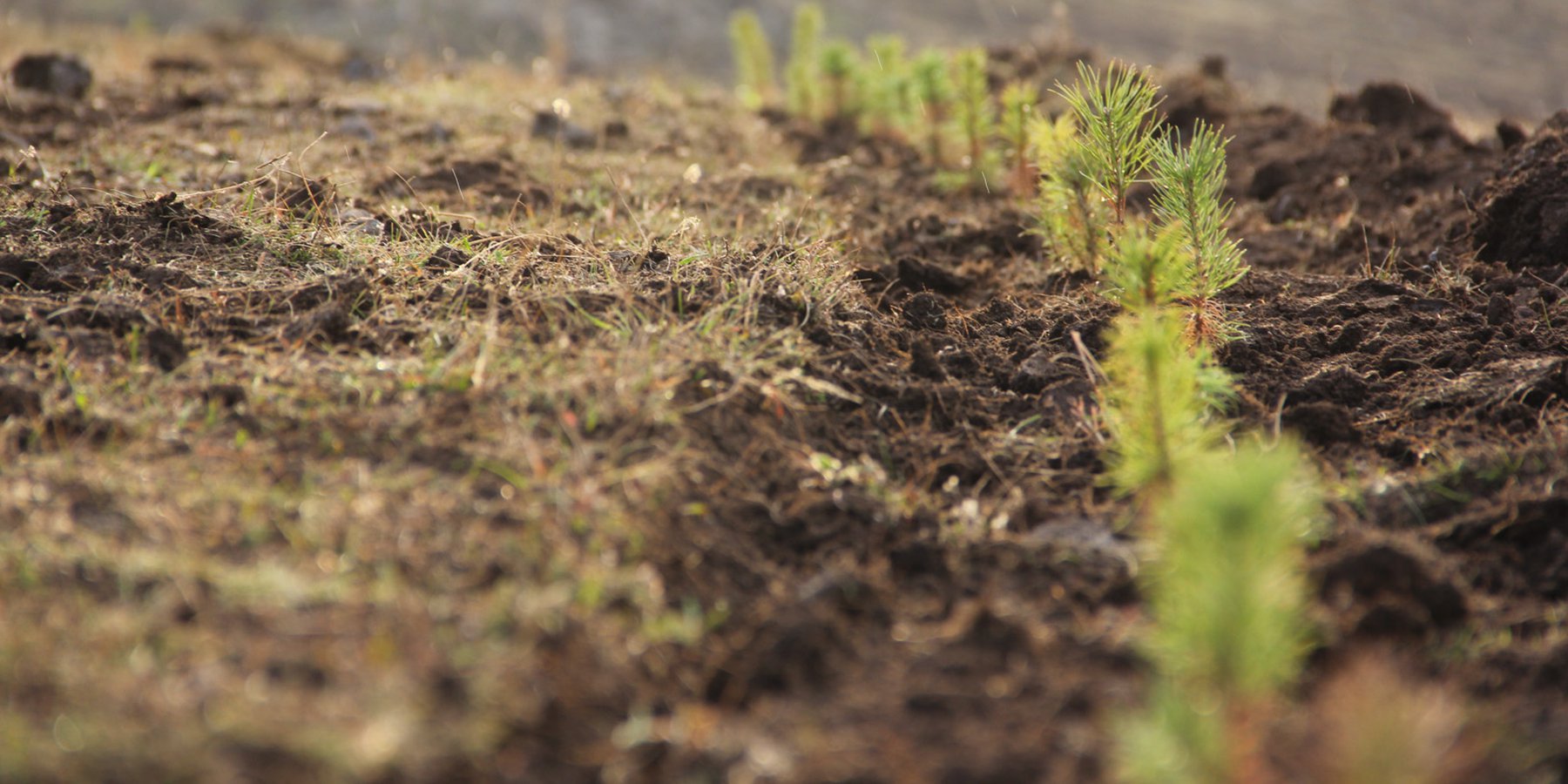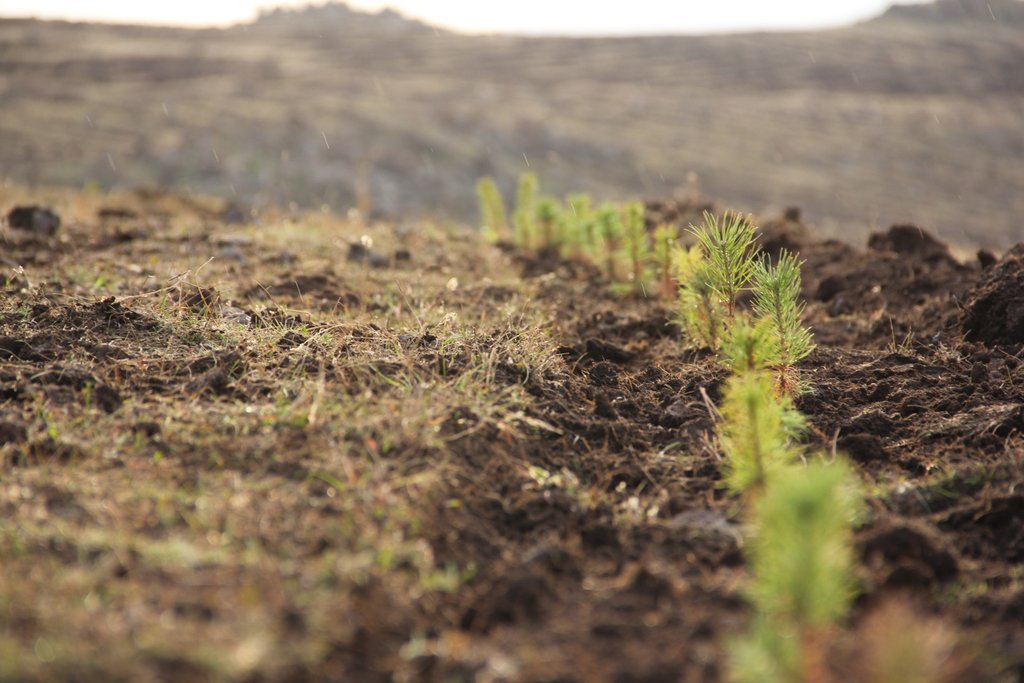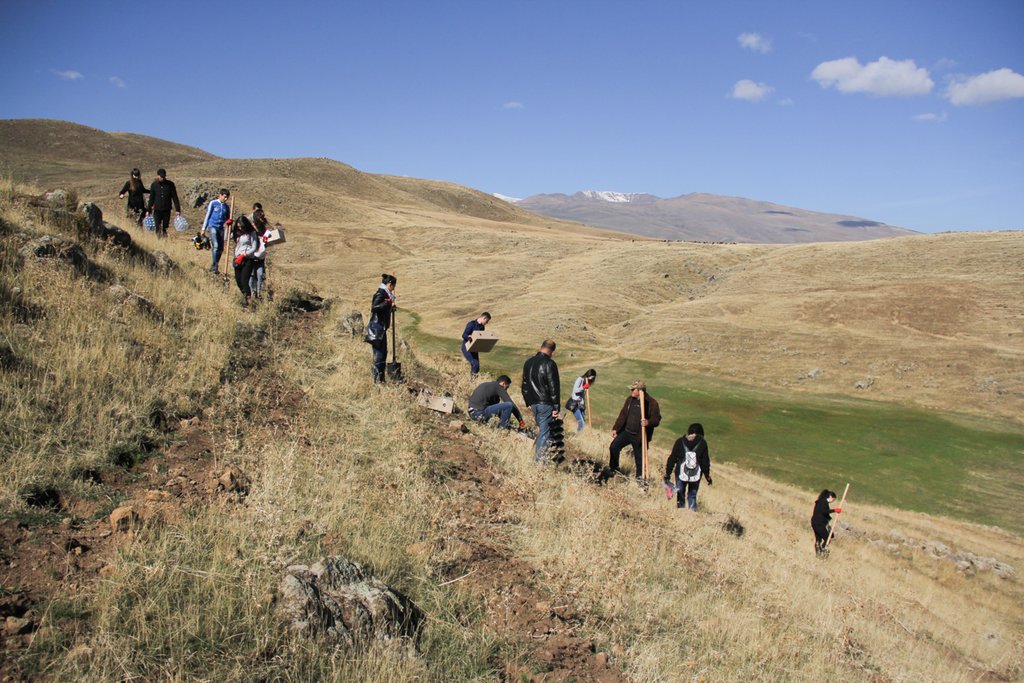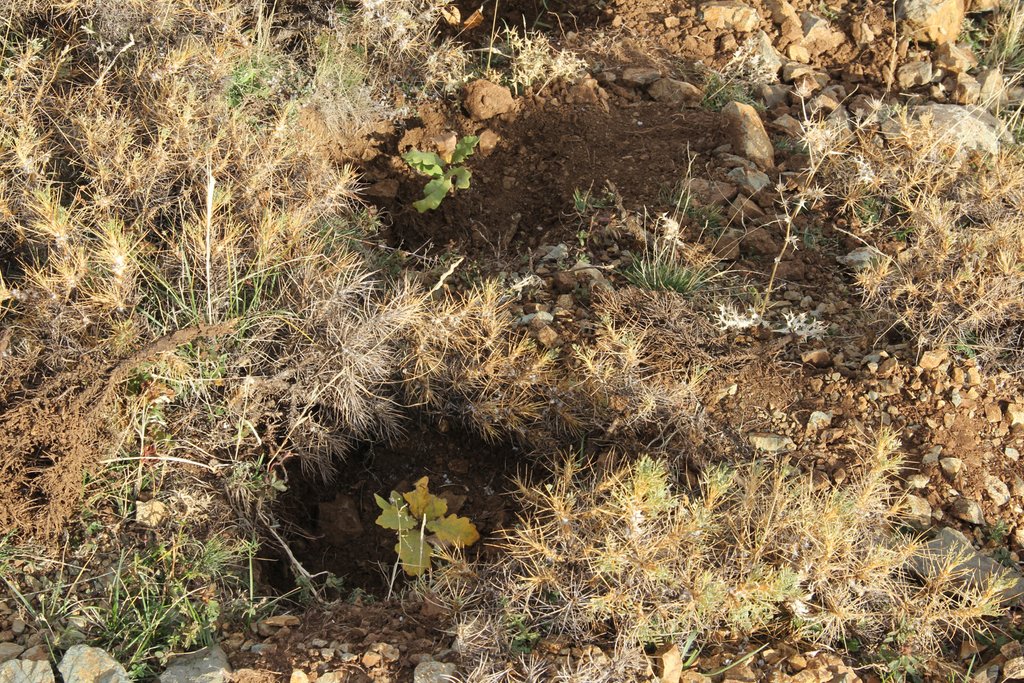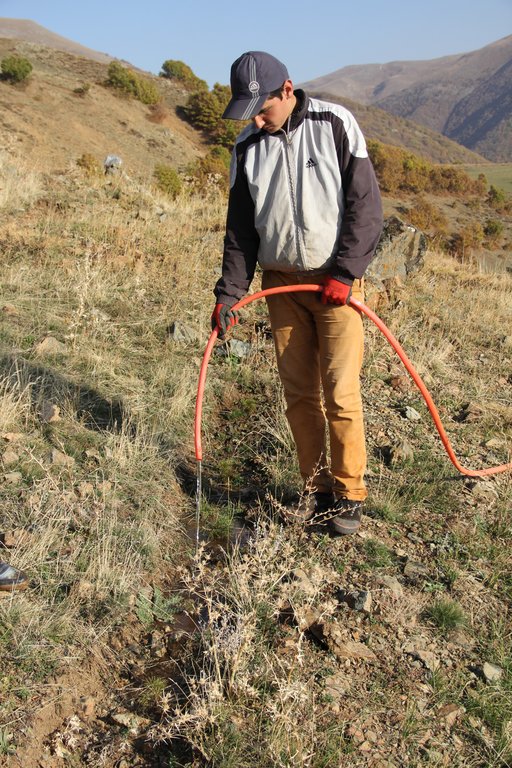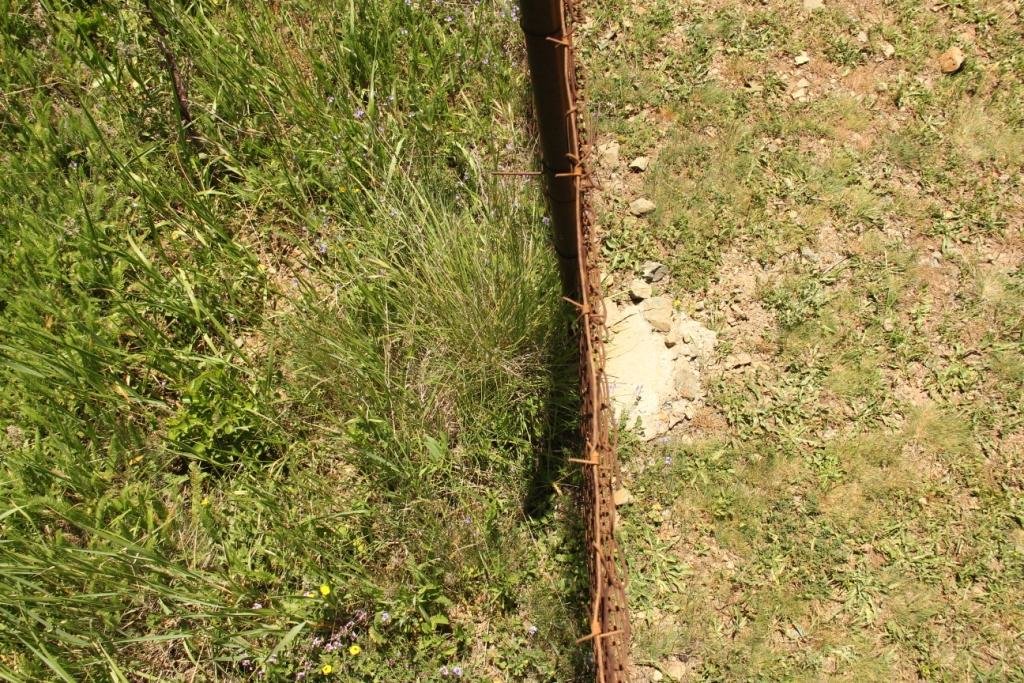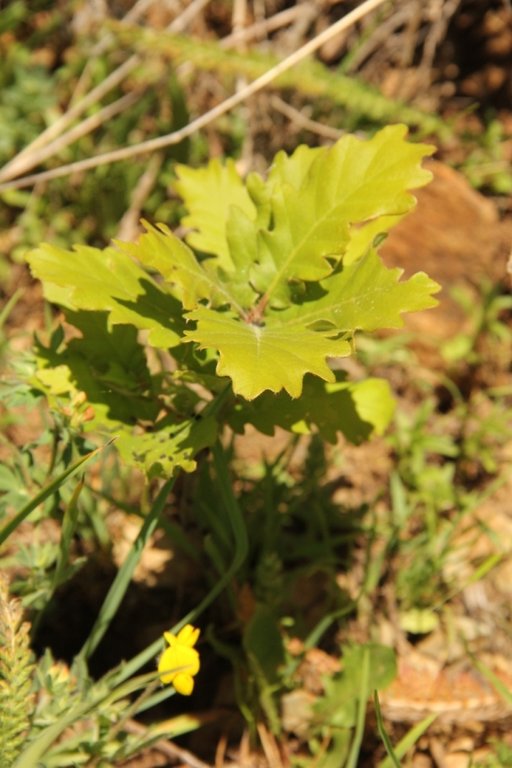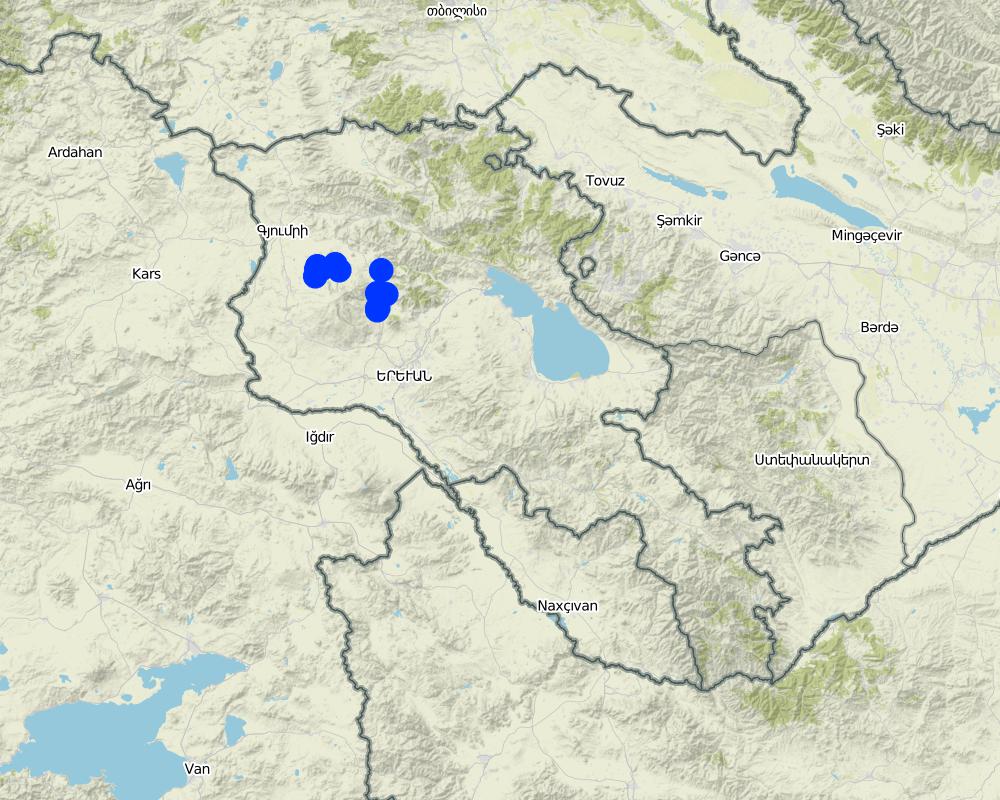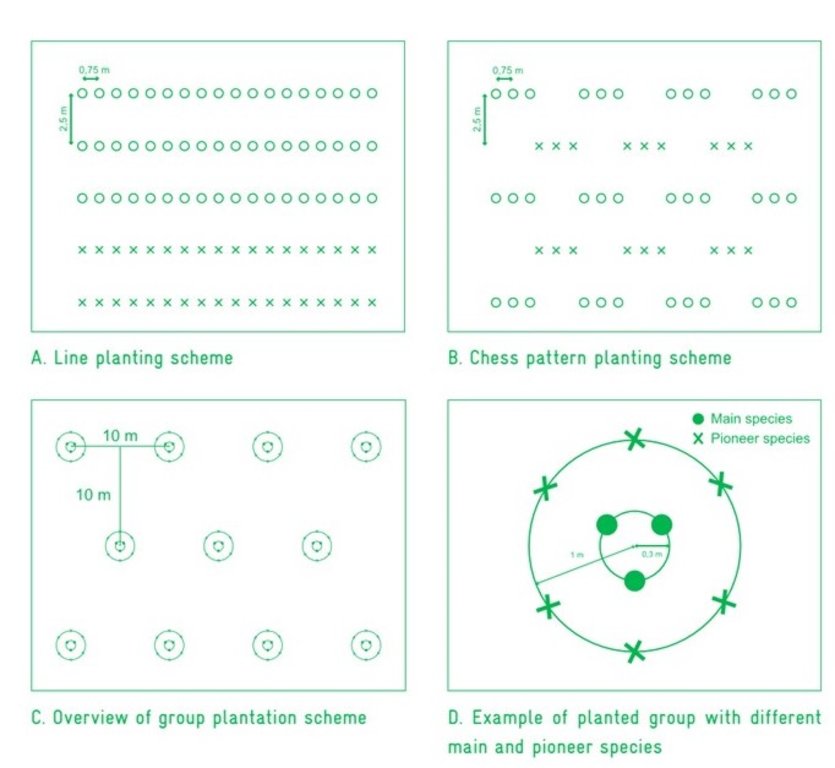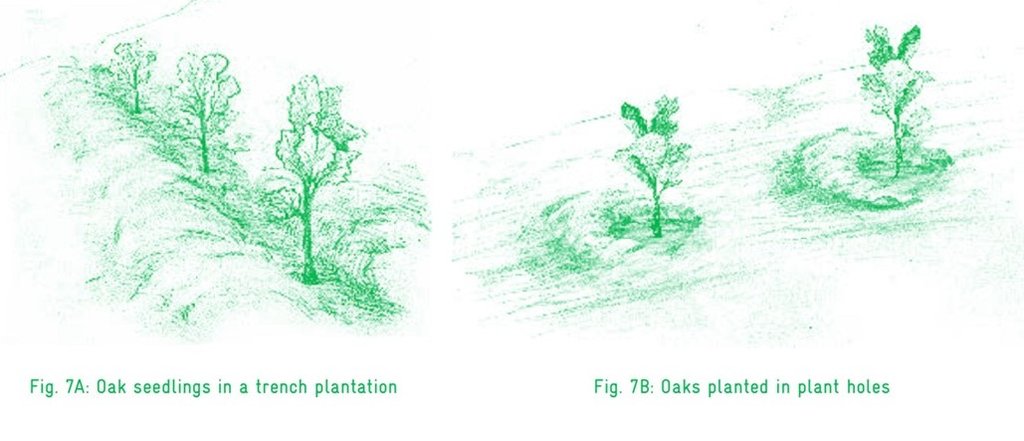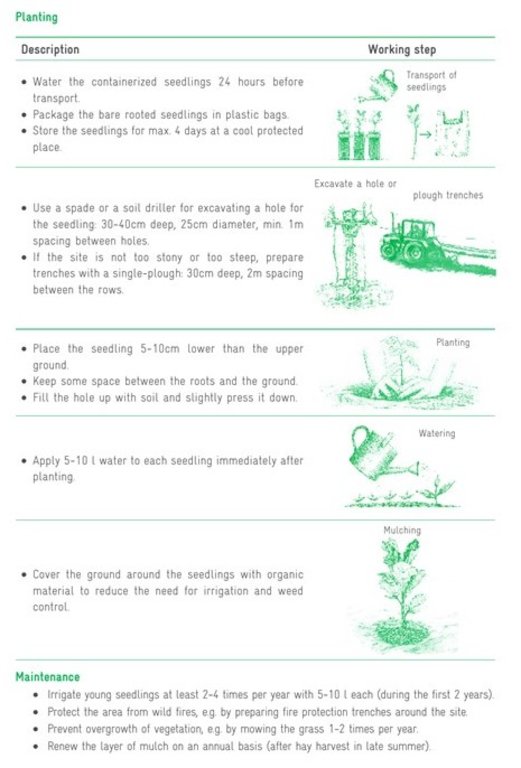High-altitude afforestation for erosion control [Armenia]
- Creación:
- Actualización:
- Compilador: Hanns Kirchmeir
- Editor: Artur Hayrapetyan
- Revisor: Ursula Gaemperli
technologies_4101 - Armenia
Visualizar secciones
Expandir todo Colapsar todos1. Información general
1.2 Detalles de contacto de las personas de referencia e instituciones involucradas en la evaluación y la documentación de la Tecnología
Especialista MST:
Nombre del proyecto que financió la documentación/ evaluación de la Tecnología (si fuera relevante)
Integrated Biodiversity Management, South Caucasus (IBiS)Nombre de la(s) institución(es) que facilitaron la documentación/ evaluación de la Tecnología (si fuera relevante)
Deutsche Gesellschaft für Internationale Zusammenarbeit (GIZ)1.3 Condiciones referidas al uso de datos documentados mediante WOCAT
¿Cuándo se compilaron los datos (en el campo)?
04/10/2018
El compilador y la/s persona(s) de referencia claves aceptan las condiciones acerca del uso de los datos documentados mediante WOCAT:
Sí
1.4 Declaración de la sostenibilidad de la Tecnología descrita
¿La Tecnología aquí descrita resulta problemática en relación a la degradación de la tierra, de tal forma que no puede considerársela una tecnología sostenible para el manejo de la tierra?
No
1.5 Referencia al (los) Cuestionario(s) de Enfoques MST
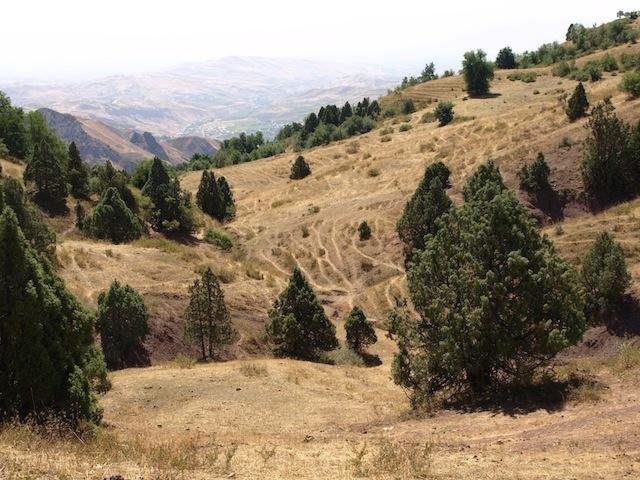
Sustainable managements on pasture and forest lands based … [Tayikistán]
Sustainable managements on pasture and forest lands based on natural regeneration by electrified fences
- Compilador: Kakubari Yochitaka

Afforestation/Tree planting [Uganda]
Tree planting carried out by individual land users on hilly slopes to improve soil cover ,reduce wind strength , provide wood fuel & household income.
- Compilador: Wilson Bamwerinde
2. Descripción de la Tecnología MST
2.1 Breve descripción de la Tecnología
Definición de la Tecnología:
Afforestation is a key technologies to protect soil against erosion and provide a wide range of ecosystem services. In this case, afforestation at high altitudes, which is particularly challenging, with the primary purpose of erosion control were planted in small patches with different methods. They form the basis for future community forests in Armenia.
2.2 Descripción detallada de la Tecnología
Descripción:
Forests are - in terms of biomass accumulation and stability - the most successful ecosystems in the world. Natural forest ecosystems offer multiple ecosystem services, such as timber and fuel wood provision, water purification, carbon sequestration. In mountainous landscapes, forests have an additional protective function against erosion and natural hazards (e.g., avalanches, landslides, debris flows or rock falls). In the South Caucasus, two natural limits restrict forest expansion: at 2.300-2.600m a.s.l. the upper tree line is visible, whereas steppe and semi-desert ecosystems form the lower tree line.
Socio-economic and geo-physical living conditions:
The intervention area is located at the northern to eastern slopes of Mount Aragats (4013m). The villages are located at 1600 to 1800 m above sea level where the slope meets a plain with stepic soils and crop production while the slopes of the mountains are used for livestock grazing (sheep and cattle).
Purpose of afforestation:
By means of afforestation of degraded pastures, mountainous areas that suffer from erosion and overgrazing should be rehabilitated and erosion protection capacity enhanced. At the same time, the afforestation sites should form the basis for future community forests providing a wide range of ecosystem services, a concept that has not yet been established in Armenia.
Implementation
Between 2014 and 2017 more than 200 hectares were fenced for afforestation, 145 ha were actively afforested in 10 different communities around Mount Aragats in Armenia. The average size of the 20 plots is 10 ha (35 ha being the largest site, 1 ha the smallest one).
The afforestation included different species combinations, planting schemes and methods to determine most cost-efficient afforestation methods for Armenian conditions. All afforestation took place at elevations between 1900 and 2300 m.a.s.l.. The afforestation included fencing of the area to protect the afforestation site against grazing, the preparation of the planting sites according to fixed planting schemes, the actual planting in lines with trenches, single plant holes and group plantings. For some sites, additional irrigation was established for the first years. Particular attention was paid to the species selection which explicitly included fruit trees and shrubs to ensure local economic returns.
Practical experiences
A wide range species was tested. Within the given climate context, pine (Pinus sylvestris), the main non-native species as well as native maple (Acer trautvetteri), Persian Oak (Quercus macranthera) and birch (Betula litwinowii) showed the best results. Particular attention was paid to adapted species to create resilient forest-shrubland with a large number of tree species. In general, planting in trenches shows highest survival rates. Bare root system and containerized seedlings were used for planting. Containerized seedlings definitely provide better survival rate in comparison with bare root system seedlings. Additionally, mulch cover was provided to protect seedlings and keep soil humidity. The main maintenance measures are repeated mulching and weed control and irrigation during the first 3 years. Furthermore, some replanting is continuously taking place as the sites are facing tough environmental conditions (hot summers, drought, short vegetation period).
The plantation was organised and supervised by local NGO's (ATP Armenian Tree Project, ESAC Environmental Sustainability Assistance Center) in close cooperation with the local village population. In a Memorandum of Understandig between the Armenian Ministry of Territorial Administration and Development, the local village administration and GIZ the share of payed labour and own contribution was fixed beforehand.
Impacts and perception
After the first years already first successes are becoming visible contributing to increased vegetation cover, increased biomass and improved soil protection. The communities are proud to be amongst the first in Armenia with a community forest. However, slow growth will require continuous commitment and care on behalf of the community.
2.3 Fotografías de la Tecnología
2.4 Videos de la Tecnología
Comentarios, descripción breve:
Short video of ESAC, the implementing NGO, on afforestation background and techniques
https://www.youtube.com/watch?v=cLZ5ucDDclI
Fecha:
28/10/2018
Lugar:
Aragatsotn and Shirak Marzes
Nombre del videógrafo:
ESAC NGO (Khachatur Khachtryan)
Comentarios, descripción breve:
Short video of ESAC, the implementing NGO on different fencing techniques used for protecting the afforestation sites
https://www.youtube.com/watch?v=INRnvnkYzCE
Fecha:
28/03/2018
Lugar:
Aragatsotn and Shirak Marzes
Nombre del videógrafo:
ESAC NGO (Khachatur Khachtryan)
2.5 País/ región/ lugares donde la Tecnología fue aplicada y que se hallan comprendidos por esta evaluación
País:
Armenia
Región/ Estado/ Provincia:
Shirak and Aragatsotn Marzes
Especifique más el lugar :
Lusagyugh, Saralanj, Harich, Arayi, Quchak, Hnaberd, Mets Manatash, Pokr Mantash, Nahapetavan
Comentarios:
Differerent small afforestation plots between 1 and 30 ha with a total of approximately 200 ha
Map
×2.6 Fecha de la implementación
Si no se conoce el año preciso, indique la fecha aproximada:
- hace menos de 10 años (recientemente)
2.7 Introducción de la Tecnología
Especifique cómo se introdujo la Tecnología:
- mediante proyectos/ intervenciones externas
Comentarios (tipo de proyecto, etc.):
This project introduced community-managed forests for erosion control to different communities. Different planting techniques and species were piloted to identify most appropriate afforestation and management methods.
3. Clasificación de la Tecnología MST
3.1 Propósito(s) principal(es) de la Tecnología MST
- reducir, prevenir, restaurar la degradación de la tierra
- conservar el ecosistema
- preservar/ mejorar biodiversidad
- mitigar cambio climático y sus impactos
3.2 Tipo(s) actuales de uso de la tierra donde se aplica la Tecnología

Tierra de pastoreo
Tierras de pastoreo extensivo:
- Semi-nomadismo/ pastoralismo
Especies y productos animales principales:
Cattle and sheep

Bosques
Plantación de árboles, reforestación:
- Variedades mixtas
Productos y servicios:
- Leña
- Frutos y nueces
- Pastoreo/ ramoneo
- Protección contra desastres naturales
Si el uso de la tierra ha cambiado debido a la implementación de la Tecnología, indique el uso de la tierra antes de la implementación de la Tecnología.
The afforestation sites were previously used as (partly overgrazed) pastures for grazing of mainly cattle. Thus, this technology included a land-use change from grassland/pasture to forest/shrubland.
3.3 Información adicional sobre el uso de tierras
Provisión de agua para la tierra donde se aplica la Tecnología:
- mixta de secano – irrigada
Número de temporadas de cultivo por año:
- 1
Densidad del ganado (si fuese relevante):
1-2/ha
3.4 Grupo MST al que pertenece la Tecnología
- manejo de bosques naturales y seminaturales:
- veda de zona (detener uso, apoyar la restauración)
- reducción de riesgos de desastres basados en el ecosistema
3.5 Difusión de la Tecnología
Especifique la difusión de la Tecnología:
- distribuida parejamente sobre un área
Si la tecnología se halla difundida homogéneamente en un área, indique el área aproximada que cubre:
- < 0.1 km2 (10 ha)
Comentarios:
Individual sites vary between 1 and 35 ha with a total area covered of 200 ha (2 km²) . However, it showed that communities only have the capacity to maintain a maximum size of 10 ha (maintenance). If managed by the community, it should not be larger.
3.6 Medidas MST que componen la Tecnología

medidas vegetativas
- V1: Cubierta de árboles y arbustos

medidas de manejo
- M1: Cambio de tipo de uso de la tierra
3.7 Principales tipos de degradación de la tierra encarados con la Tecnología

erosión de suelos por agua
- Wt: pérdida de capa arable/ erosión de la superficie
- Wg: erosión en cárcavas

degradación biológica
- Bc: reducción de la cobertura vegetal del suelo
- Bs: reducción en la calidad y composición/ diversidad de las especies
3.8 Prevención, reducción o restauración de la degradación de la tierra
Especifique la meta de la Tecnología con relación a la degradación de la tierra:
- prevenir la degradación de la tierra
- reducir la degradación de la tierra
4. Especificaciones técnicas, actividades de implementación, insumos y costos
4.1 Dibujo técnico de la Tecnología
4.2 Especificaciones técnicas/ explicaciones del dibujo técnico
Needed resources for 1 ha afforestation:
- 2.000-5.000 seedlings
- 10-50 t water (for initial irrigation)
- 40 – 100 working days
- Shuffles or soil driller
- Means of transport
Selection of species
It is recommended to use different local tree species for any afforestation activity, as they can cope best with the given environmental conditions and, therefore, are more resilient towards pests and climatic variations. Most suitable species for afforestation:
-Trautvetters maple (Acer trautvetteri)
-Birch (Betula letwinowii)
-Wild Oriental Apple (Malus orientalis)
-Scott’s Pine (Pinus sylvestris var. hamata)
-Persian Oak (Quercus macranthera)
-Raspberry (Rubus idaeus)
-Mountain ash (Sorbus aucuparia)
For selecting suitable species, screening of the wider project area is essential in order to prepare a list of species, which would naturally grow under the given ecological conditions
Planting scheme
The technical drawings describe different potential planting schemes. A further figure describes the advantages and disadvantages of each scheme.
Planting season
The climate in the South Caucasus region shows low precipitation rates in the summer period. As seedlings have a small root system, young trees are more sensitive to drought. The best time for planting is either autumn or early spring as during autumn, winter and spring, more moisture is available that helps the seedlings to develop deeper root systems to survive during summer droughts.
Fencing
In many cases, afforestation sites are located on pasture land. To protect the planted seedlings from browsing by livestock or wild game, it is recommended to fence the afforestation site before starting the plantation of the seedlings.
Planting
The planting process is specified in one of the technical drawings. With a hole driller planting of one tree takes 2-4 minutes, planting by hand 8-10 min. Each seedling is waterered with an intial 5-10 l of water.
4.3 Información general sobre el cálculo de insumos y costos
Especifique cómo se calcularon los costos e insumos:
- por área de Tecnología
Indique tamaño y unidad de área:
1 ha
Especifique la moneda usada para calcular costos:
- dólares americanos
4.4 Actividades de establecimiento
| Actividad | Tipo de medida | Momento | |
|---|---|---|---|
| 1. | Selection of afforestation site, plantation scheme and species | Manejo | anytime |
| 2. | Fencing of the area (if area is being grazed or wild game is browsing seedlings | Estructurales | before planting |
| 3. | Prepare and transfer seedlings to the site | Manejo | before planting |
| 4. | Excavate whole for the seedling (30-40cm deep, 25 cm diameter, 1m spacing between wholes) | Estructurales | autumn, early spring |
| 5. | Place the seedling and fill hole with soil | Vegetativas | autumn, early spring |
| 6. | Apply 5-10 l of water immediately after planting | Manejo | after planting |
| 7. | Cover soil around seedling with mulch and organic material | Vegetativas | after planting |
4.5 Costos e insumos necesarios para el establecimiento
| Especifique insumo | Unidad | Cantidad | Costos por unidad | Costos totales por insumo | % de los costos cubiertos por los usuarios de las tierras | |
|---|---|---|---|---|---|---|
| Mano de obra | Local workers for plantation of trees | seedlings | 2500,0 | 0,27 | 675,0 | 10,0 |
| Mano de obra | Installation of fence and posts | person day | 191,0 | 12,3 | 2349,3 | |
| Equipo | Equipment (hummer, driller, etc.) | set | 1,0 | 141,8 | 141,8 | 30,0 |
| Material para plantas | Tree seedlings | pieces | 2500,0 | 0,31 | 775,0 | |
| Material para plantas | Mulching | kg | 1250,0 | 0,03 | 37,5 | |
| Material de construcción | Fencing (permanent mesh wire fence) | meter | 317,0 | 1,35 | 427,95 | 10,0 |
| Material de construcción | Irrigation system | set | 1,0 | 889,0 | 889,0 | 15,0 |
| Material de construcción | Metal posts for fence (1.8m) | pieces | 106,0 | 2,97 | 314,82 | |
| Material de construcción | sand | kg | 3444,0 | 0,012 | 41,33 | |
| Material de construcción | Other material(electrode, wire armature, metal disc) | set | 1,0 | 386,9 | 386,9 | 20,0 |
| Material de construcción | Cement | kg | 1148,0 | 0,12 | 137,76 | |
| Otros | Transporation of mulch | time | 1,0 | 102,8 | 102,8 | |
| Otros | Transporation of construction materials | time | 5,0 | 92,5 | 462,5 | |
| Otros | Transporation of workers to the field | time | 15,0 | 30,2 | 453,0 | |
| Otros | Transporation of seedlings | time | 1,0 | 51,4 | 51,4 | |
| Costos totales para establecer la Tecnología | 7246,06 | |||||
Si el usuario de la tierra no cubrió el 100% de los costos, indique quién financió el resto del costo:
GIZ Project
Comentarios:
The above calculation is not made on purely 1 ha, since the project did not implement afforestation on 1 ha. This calculation was done on 2.6 ha, then the costs are proportionally distributed for 1 ha.
4.6 Actividades de establecimiento/ recurrentes
| Actividad | Tipo de medida | Momento/ frequencia | |
|---|---|---|---|
| 1. | Irrigation of young seedlings with 5-10 l | Manejo | 2-4 times per year for the first two years |
| 2. | Preparation of fire protection trenches | Estructurales | if needed |
| 3. | Mowing to prevent overgrowth of seedlings | Vegetativas | 1-2 times per year |
| 4. | Renew mulch layer | Manejo | annually after hay harvest in summer |
| 5. | Replanting of seedlings (10% each year) | Manejo | annually to be done for the first 5 years |
4.7 Costos e insumos necesarios para actividades de mantenimiento/ recurrentes (por año)
| Especifique insumo | Unidad | Cantidad | Costos por unidad | Costos totales por insumo | % de los costos cubiertos por los usuarios de las tierras | |
|---|---|---|---|---|---|---|
| Mano de obra | Irrigation of young seedlings with 5-10 l | Man/day | 1,0 | 10,0 | 10,0 | 100,0 |
| Mano de obra | Preparation of fire protection trenches | rm | 150,0 | 0,34 | 51,0 | 100,0 |
| Mano de obra | Mowing to prevent overgrowth of seedlings | Man/day | 4,0 | 10,0 | 40,0 | 50,0 |
| Mano de obra | Renew mulch layer (including mulch value) | Man/day | 5,0 | 10,0 | 50,0 | 50,0 |
| Material para plantas | Seedlings for replantation (including labour) | seedlings | 1200,0 | 0,51 | 612,0 | 50,0 |
| Otros | Petrol for irrigation | liter | 7,0 | 0,8 | 5,6 | |
| Indique los costos totales para mantenecer la Tecnología | 768,6 | |||||
Si el usuario de la tierra no cubrió el 100% de los costos, indique quién financió el resto del costo:
GIZ project
Comentarios:
The rather high costs are mostly linked to the permanent fence to protect seedlings against grazing and to high number of seedlings per hectare. In some parts initial irrigation was necessary due to dry summer conditions. Maintenance activities such as irrigation of seedlings in summer, anti-fire measures, replantation of seedlings (10 % each year for 5 years), mowing of grass and renewing of mulch layer are needed.
4.8 Factores más determinantes que afectan los costos:
Describa los factores más determinantes que afectan los costos:
With costs of approximately 5,700 USD/ha including fencing (30%), planting (30%) and seedlings (40%) afforestation is very intensive in financial resources. It is very likely that these high costs will limit the upscaling of the afforestation process. There are some options to reduce costs:
•Fence large areas and try to have sites in square or circle shape
•Increase number of seedlings planted by person by using soil-drillers
•Use cheaper fencing material (e.g. game protection fence, poles without concrete)
•Reduce seedling number to 2000-3000 seedlings/ha
•Using seeds (e.g. oak) instead of seedlings
•Regrow seeds in local low-cost nurseries (e.g. Lusagyugh)
5. Entorno natural y humano
5.1 Clima
Lluvia anual
- < 250 mm
- 251-500 mm
- 501-750 mm
- 751-1,000 mm
- 1,001-1,500 mm
- 1,501-2,000 mm
- 2,001-3,000 mm
- 3,001-4,000 mm
- > 4,000 mm
Especifique el promedio anual de lluvia (si lo conoce), en mm:
521,00
Especificaciones/ comentarios sobre la cantidad de lluvia:
Precipitation peak between May and June.
Indique el nombre de la estación metereológica de referencia considerada:
Aparan, Aragatsotn Marz, Armenia
Zona agroclimática
- semi-árida
According to Köppen and Geiger, the climate is classified as Dfb (Cold/continental, no dry season, warm summers). Annual mean temperature is 5.2. °C. The warmest month of the year is August, with an average temperature of 16.4 °C. January has the lowest average temperature of the year with -6.9 °C.
based on data from the following source: https://www.arcgis.com/home/webmap/viewer.html?layers=3ac478a468c245ef9bfd5533f7edbf93
5.2 Topografía
Pendientes en promedio:
- plana (0-2 %)
- ligera (3-5%)
- moderada (6-10%)
- ondulada (11-15%)
- accidentada (16-30%)
- empinada (31-60%)
- muy empinada (>60%)
Formaciones telúricas:
- meseta/ planicies
- cordilleras
- laderas montañosas
- laderas de cerro
- pies de monte
- fondo del valle
Zona altitudinal:
- 0-100 m s.n.m.
- 101-500 m s.n.m.
- 501-1,000 m s.n.m
- 1,001-1,500 m s.n.m
- 1,501-2,000 m s.n.m
- 2,001-2,500 m s.n.m
- 2,501-3,000 m s.n.m
- 3,001-4,000 m s.n.m
- > 4,000 m s.n.m
Indique si la Tecnología se aplica específicamente en:
- no relevante
5.3 Suelos
Profundidad promedio del suelo:
- muy superficial (0-20 cm)
- superficial (21-50 cm)
- moderadamente profunda (51-80 cm)
- profunda (81-120 cm)
- muy profunda (>120 cm)
Textura del suelo (capa arable):
- mediana (limosa)
Textura del suelo (> 20 cm debajo de la superficie):
- mediana (limosa)
Materia orgánica de capa arable:
- media (1-3%)
5.4 Disponibilidad y calidad de agua
Agua subterránea:
5-50 m
Disponibilidad de aguas superficiales:
mediana
Calidad de agua (sin tratar):
agua potable de mala calidad (requiere tratamiento)
¿La salinidad del agua es un problema?
No
¿Se está llevando a cabo la inundación del área? :
No
5.5 Biodiversidad
Diversidad de especies:
- mediana
Diversidad de hábitats:
- baja
5.6 Las características de los usuarios de la tierra que aplican la Tecnología
Sedentario o nómada:
- Sedentario
Orientación del mercado del sistema de producción:
- mixta (subsistencia/ comercial)
Ingresos no agrarios:
- 10-50% de todo el ingreso
Nivel relativo de riqueza:
- pobre
- promedio
Individuos o grupos:
- grupos/ comunal
- cooperativa
Nivel de mecanización:
- trabajo manual
- mecanizado/motorizado
Género:
- mujeres
- hombres
Edad de los usuarios de la tierra:
- personas de mediana edad
- ancianos
5.7 Área promedio de la tierra que pertenece a o es arrendada por usuarios de tierra que aplican la Tecnología
- < 0.5 ha
- 0.5-1 ha
- 1-2 ha
- 2-5 ha
- 5-15 ha
- 15-50 ha
- 50-100 ha
- 100-500 ha
- 500-1,000 ha
- 1,000-10,000 ha
- > 10,000 ha
¿Esto se considera de pequeña, mediana o gran escala (refiriéndose al contexto local)?
- pequeña escala
5.8 Tenencia de tierra, uso de tierra y derechos de uso de agua
Tenencia de tierra:
- comunitaria/ aldea
Derechos de uso de tierra:
- comunitarios (organizado)
Derechos de uso de agua:
- comunitarios (organizado)
5.9 Acceso a servicios e infraestructura
salud:
- pobre
- moderado
- bueno
educación:
- pobre
- moderado
- bueno
asistencia técnica:
- pobre
- moderado
- bueno
empleo (ej. fuera de la granja):
- pobre
- moderado
- bueno
mercados:
- pobre
- moderado
- bueno
energía:
- pobre
- moderado
- bueno
caminos y transporte:
- pobre
- moderado
- bueno
agua potable y saneamiento:
- pobre
- moderado
- bueno
servicios financieros:
- pobre
- moderado
- bueno
6. Impactos y comentarios para concluir
6.1 Impactos in situ demostrados por la Tecnología
Impactos socioeconómicos
Producción
producción de forraje
Comentarios/ especifique:
Within the fenced afforestation site, the grass could be cut and used as hay. The protection from grazing helps biomass development which leads to better protection from Surface water Erosion and this lead to soil-regeneration and increase of productivity.
calidad de bosques
Comentarios/ especifique:
The natural forest was removed for the purpose of grazing and the forest cover will be now re-established on the afforestation sites.
producción de productos forestales no madereros
Comentarios/ especifique:
We mixed shrub species like raspberries and fruit-trees (wilde plumb) between the main tree species to create short time Benefit for the village people.
diversidad de producto
Comentarios/ especifique:
In addition to the wide spread grazing land use now the hay production in the fenced afforestation site is increased for the first 1-2 decades (until the canopy is too dense) and the collection of berries and fruits give additional income opportunities. In the Long terme fuel wood production can be expected from the forested land.
área de producción
Comentarios/ especifique:
The grazing range is limited by the fenced afforestation site. This is relevant in the first couple of years before hay or fruit/berry productivity is able to fully compensate the loss of grazing range.
Ingreso y costos
carga de trabajo
Comentarios/ especifique:
The maintenance of the afforestation site lead to increase of workload especially in the first 2-4 years when hay cutting and Irrigation is needed until the tree seedlings are well established.
Impactos socioculturales
oportunidades recreativas
Comentarios/ especifique:
As there is almost no forest near to the villages every woodland is very attractive for recreational purpose, but it will Need 2-3 decades until this function will be fulfilled by the afforestation site.
MST/ conocimiento de la degradación de la tierra
Comentarios/ especifique:
The local stakeholders got hands on training on fencing, afforestation and maintenance of afforestation sites.
Impactos ecológicos
Ciclo de agua/ escurrimiento de sedimento
escurrimiento superficial
Comentarios/ especifique:
The fencing of the afforestation site immediately stops the heavy grazing Impact which leads to fast recovery of the Vegetation. The improved Vegetation cover and better development of the root System reduce Surface water run of Speed and increase water Infiltration.
evaporación
Comentarios/ especifique:
An increase of vegetation and the leaf area index will lead to an increase of evaporation.
Suelo
pérdida de suelo
Comentarios/ especifique:
Increase of vegetation cover and reduction of water runoff will lead to decrease of soil loss.
materia orgánica debajo del suelo C
Comentarios/ especifique:
The increase of vegetation leads to an increase of root development. Additionally, the increase of vegetation produces more litter, as no grazing is applied. The increase in litter leads to an increase of an humus layer and therefore to more below ground carbon.
Biodiversidad: vegetación, animales
Cubierta vegetal
Comentarios/ especifique:
Especially the fencing leads to fast increase of vegetation cover.
biomasa/ sobre suelo C
Comentarios/ especifique:
The local stakeholders got hands on training on fencing, afforestation and maintenance of afforestation sites.
diversidad vegetal
Comentarios/ especifique:
The stop of grazing and the new micro-habitats created by the shadow of the tree seedlings have let to an increase in plant diversity. This process might be reverse when the tree canopy is closed and less light is available for the herb-layer, but this will take several decades.
diversidad de hábitats
Comentarios/ especifique:
The plain grasslands habitats are diversified by patches of forest.
6.2 Impactos fuera del sitio demostrados por la Tecnología
capacidad de amortiguación/ filtrado
Comentarios/ especifique:
The decrease of water run off increase the water capacity of the habitat and the afforested area will provide increase buffer capacity in the case of intensive rainfalls.
sedimentos transportados por el viento
Comentarios/ especifique:
The high grass and trees reduce wind speed at ground level.
Comentarios acerca de la evaluación del impacto:
Most of the afforestation sites are locate uphill of villages. Village people are expecting protection from cold down-hill winds from the mountain and an increase of air-moisture by the evapo-transpiration of the forest.
6.3 Exposición y sensibilidad de la Tecnología al cambio climático gradual y a extremos relacionados al clima/ desastres (desde la percepción de los usuarios de tierras)
Extremos (desastres) relacionados al clima
Desastres climatológicos:
| ¿Cómo es que la tecnología soporta esto? | |
|---|---|
| tormenta local | moderadamente |
| granizada local | moderadamente |
| tormenta de nieve local | bien |
Desastres biológicos
| ¿Cómo es que la tecnología soporta esto? | |
|---|---|
| insectos/ infestación de gusanos | moderadamente |
Otras consecuencias relacionadas al clima
Otras consecuencias relacionadas al clima
| ¿Cómo es que la tecnología soporta esto? | |
|---|---|
| período extendido de crecimiento | bien |
6.4 Análisis costo-beneficio
¿Cómo se comparan los beneficios con los costos de establecimiento (desde la perspectiva de los usuarios de tierra)?
Ingresos a corto plazo:
negativo
Ingresos a largo plazo:
ligeramente positivo
¿Cómo se comparan los beneficios con los costos de mantenimiento/ recurrentes (desde la perspectiva de los usuarios de tierra)?
Ingresos a corto plazo:
ligeramente negativo
Ingresos a largo plazo:
positivo
Comentarios:
In the first decade the efforts on maintenance are high and it can be expected that the return of natural resources (hay, berries, fruits) is significantly lower the the maintenance efforts. As soon the trees are established and larger than 1.3 the root system is well establish and the trees are resistant to droughts, no vegetation cutting is needed and even game or cattle browsing will not necessarily lead to lethal damage.
6.5 Adopción de la Tecnología
- casos individuales / experimentales
De todos quienes adoptaron la Tecnología, ¿cuántos lo hicieron espontáneamente, es decir, sin recibir incentivos/ pagos materiales?
- 0-10%
6.6 Adaptación
¿La tecnología fue modificada recientemente para adaptarse a las condiciones cambiantes?
Sí
Si fuera así, indique a qué condiciones cambiantes se adaptó:
- cambios climáticos / extremos
Especifique la adaptación de la Tecnología (diseño, material/ especies, etc.):
drought-adapted species, adaptation of planting schemes
6.7 Fuerzas/ ventajas/ oportunidades de la Tecnología
| Fuerzas/ ventajas/ oportunidades desde la perspectiva del usuario de la tierra |
|---|
| Extension of forest cover of communities, new habitat for wild creators, forest will be a fire wood and non timber products source for local inhabitants, attraction of tourists into the communities, increased water regulating function, improved soil quality, increased vegetation, microclimate formation function, wind velocity reduction, reduced land degradation, nice view of the area due to afforestation,increased fodder for cattle |
| empowerment of the local capacities on sustainable land management |
| successful demonstration of erosion control measures |
| Fuerzas/ ventajas/ oportunidades desde la perspectiva del compilador o de otra persona de referencia clave |
|---|
| Diversification of land use options for local stakeholders. Future options for sustainable firewood supply, non-timber forests products (berries) and recreation |
| Option to use grass from cutting in between as fodder/hay production |
| side-effect of fencing is increase in biodiversity of grassland species due to exclusion from grazing. |
6.8 Debilidades/ desventajas/ riesgos de la Tecnología y formas de sobreponerse a ellos
| Debilidades/ desventajas/ riesgos desde la perspectiva del usuario de la tierra | ¿Cómo sobreponerse a ellas? |
|---|---|
| Reduces pasture land of community, which was converted into a forest | Villagers/farmers need to increase the amount of hay from their homestead gardens using irrigation |
| Debilidades/ desventajas/ riesgos desde la perspectiva del compilador o de otra persona de referencia clave | ¿Cómo sobreponerse a ellas? |
|---|---|
| strong need for care taking in the first years | community commitment, strong ownership |
| Expensive due to high costs for fencing | Consider alternative, cheaper fencing methods (e.g. wildlife protection fence) |
| Complicated decision making processes by the project | More mandate given to the implementing NGOs |
7. Referencias y vínculos
7.1 Métodos/ fuentes de información
- visitas de campo, encuestas de campo
- entrevistas con usuarios de tierras
- entrevistas con especialistas/ expertos en MST
2 international (Huber, Kirchmeir)
national?
- compilación de informes y otra documentación existente
Information extracted from different project reports and submitted financial statements from implementation
7.2 Vínculos a las publicaciones disponibles
Título, autor, año, ISBN:
Handbook on Integrated Erosion Control A Practical Guide for Planning and Implementing Integrated Erosion Control Measures in Armenia, GIZ (ed.), 2018, ISBN 978-9939-1-0721-9
¿Dónde se halla disponible? ¿Costo?
GIZ Armenia
7.3 Vínculos a la información relevante disponible en línea
Título/ descripción:
Project website of the GIZ program
URL:
http://biodivers-southcaucasus.org/
Vínculos y módulos
Expandir todo Colapsar todosVínculos

Sustainable managements on pasture and forest lands based … [Tayikistán]
Sustainable managements on pasture and forest lands based on natural regeneration by electrified fences
- Compilador: Kakubari Yochitaka

Afforestation/Tree planting [Uganda]
Tree planting carried out by individual land users on hilly slopes to improve soil cover ,reduce wind strength , provide wood fuel & household income.
- Compilador: Wilson Bamwerinde
Módulos
No se hallaron módulos


